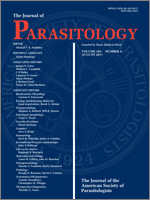Fleas (Insecta: Siphonaptera) are hematophagous ectoparasites that can reduce the fitness of vertebrate hosts. Laboratory populations of fleas decline under dry conditions, implying that populations of fleas will also decline when precipitation is scarce under natural conditions. If precipitation and hence vegetative production are reduced, however, then herbivorous hosts might suffer declines in body condition and have weakened defenses against fleas, so that fleas will increase in abundance. We tested these competing hypotheses using information from 23 yr of research on 3 species of colonial prairie dogs in the western United States: Gunnison's prairie dog (Cynomys gunnisoni, 1989–1994), Utah prairie dog (Cynomys parvidens, 1996–2005), and white-tailed prairie dog (Cynomys leucurus, 2006–2012). For all 3 species, flea-counts per individual varied inversely with the number of days in the prior growing season with >10 mm of precipitation, an index of the number of precipitation events that might have caused a substantial, prolonged increase in soil moisture and vegetative production. Flea-counts per Utah prairie dog also varied inversely with cumulative precipitation of the prior growing season. Furthermore, flea-counts per Gunnison's and white-tailed prairie dog varied inversely with cumulative precipitation of the just-completed January and February. These results complement research on black-tailed prairie dog (Cynomys ludovicianus) and might have important ramifications for plague, a bacterial disease transmitted by fleas that devastates populations of prairie dogs. In particular, our results might help to explain why, at some colonies, epizootics of plague, which can kill >95% of prairie dogs, are more likely to occur during or shortly after periods of reduced precipitation. Climate change is projected to increase the frequency of droughts in the grasslands of western North America. If so, then climate change might affect the occurrence of plague epizootics among prairie dogs and other mammalian species that associate with them.
How to translate text using browser tools
1 August 2017
Precipitation, Climate Change, and Parasitism of Prairie Dogs by Fleas that Transmit Plague
David A. Eads,
John L. Hoogland
ACCESS THE FULL ARTICLE

Journal of Parasitology
Vol. 103 • No. 4
August 2017
Vol. 103 • No. 4
August 2017





